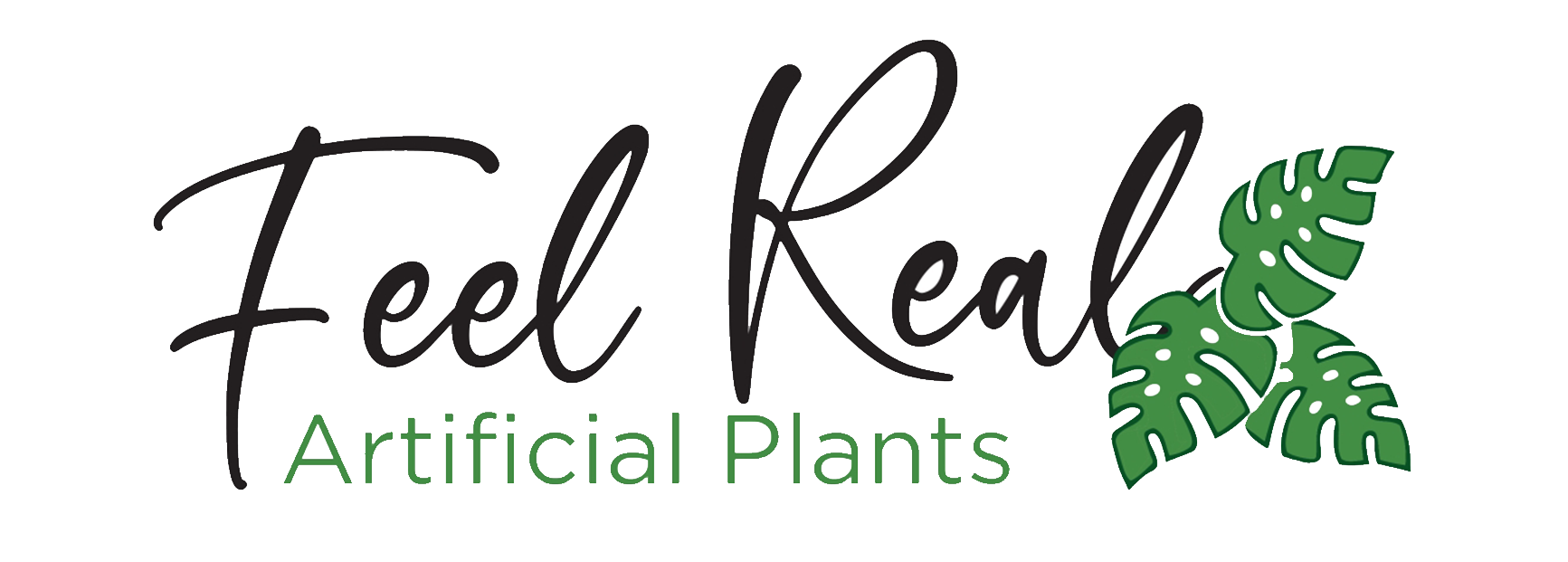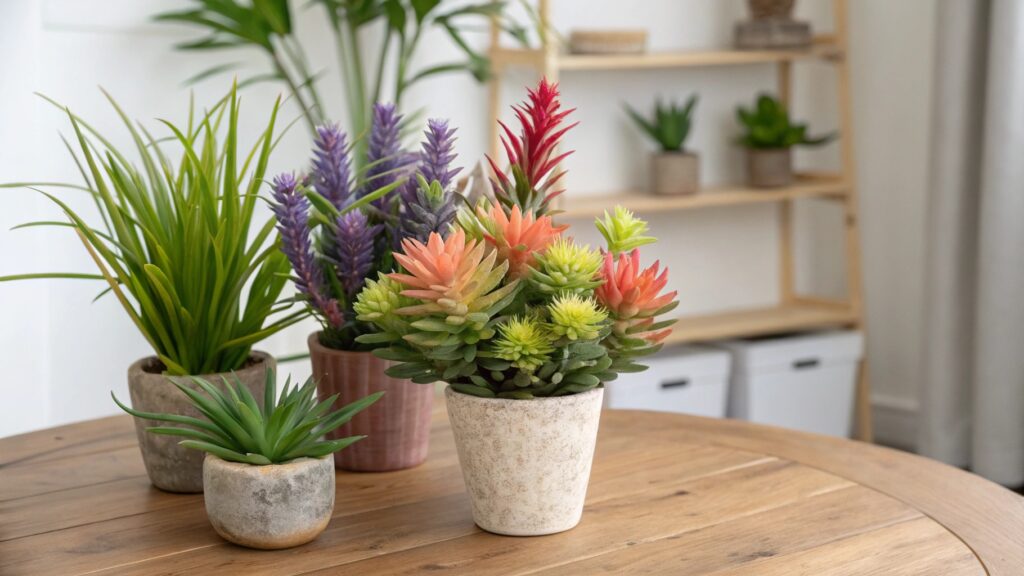Are you worried about bringing harmful chemicals into your space with faux plants? You want green plants, but safety concerns may hold you back. Let’s discover the truth about artificial plant safety.
Most modern artificial plants are safe for normal display and pose no risk of toxicity. The key is material and quality of the plants. Nowadays, most artificial plants made from safer materials like Polyethylene (PE) and adhering to strict regulations are generally not toxic.
Old and cheap products may contain harmful substances. Therefore, by choosing a reputable brand, paying attention to material labels, and ensuring good ventilation, you can minimize potential risks and enjoy the convenience and beauty of your fake plants.
Understanding what goes into artificial plants is key to making safe choices. Let’s explore the materials, potential risks, and safety regulations of fake plants.
What are the raw materials of fake plants, and do these materials pose health risks?
You see beautiful artificial plants everywhere, but what are they actually made of? Are those materials safe to have in your office or home?
Common materials of fake plants include plastics like Polyethylene (PE), Polyvinyl Chloride (PVC), polyester fabric (for leaves/flowers), and sometimes natural wood (for trunks). PE and high-quality polyester are generally considered safer and more stable. The primary health concerns often link to lower-quality PVC, which may contain plasticizers like certain phthalates to make it flexible. Nowadays most manufacturers often prefer PE blends and rigorously test materials to minimize potential risks, ensuring better artificial plant safety.
Here’s a simple comparison:
| Feature | Polyethylene (PE) | Polyvinyl Chloride (PVC) | Polyester Fabric |
|---|---|---|---|
| Safety | Generally considered safer | Potential concerns (plasticizers, stabilizers) | Generally inert |
| Flexibility | Naturally flexible | Requires plasticizers (e.g., phthalates) | Depends on weave/treatment |
| Realism | Can be very realistic | Can look realistic, sometimes more ‘plastic’ | Excellent for petals/fine leaves |
| Cost | Often slightly higher cost | Often lower cost | Varies |
| Regulations | Fewer restricted additives needed | Subject to regulations (phthalates, lead) | Dyes/coatings may be regulated |
Can Artificial Plants Release Harmful VOCs (Volatile Organic Compounds) into Indoor Air?
Have you ever unpacked a new plastic item and noticed a chemical smell? That smell often comes from VOCs.
Those plants made from certain materials like PVC, can release VOCs. These are chemicals that turn into gas at room temperature. Factors like material type, glues, dyes, and storage conditions affect emissions. While usually low, significant off-gassing from poor-quality products can impact indoor air quality. Choosing plants made from low-VOC materials like PE and ensuring good ventilation initially helps minimize exposure.
Should You Worry About Lead, Phthalates, or Other Chemicals in Fake Plants?
You might hear concerns about specific chemicals like lead or phthalates sometimes found in plastics. Is this a real risk with artificial plants?
There is only potential concern with low-quality artificial plants. High-quality manufacturers avoid restricted substances and test their products. You can ask for compliance documentation (like RoHS or REACH reports) helps ensure the plants you source don’t contain concerning levels of these chemicals.
Identifying and Avoiding Risky Chemicals
Choose reputable brands or Suppliers who offer more information about their materials or adherence to safety standards. Avoid unnamed plastics, strong initial smells, and opting for known safer materials like PE significantly minimizes your exposure to potentially harmful chemicals from artificial plants.
What Safety Certifications Should you Look For When Sourcing Artificial Plants?
Look for documentation confirming compliance with key regulations like REACH (SVHC declaration) and RoHS. For fire safety in commercial spaces,you can ask for specific fire retardancy test reports meeting standards like NFPA 701 (USA) or BS 5852 (UK/EU).
Documentation for Assessing Product Safety & Quality:
| Documentation / Certification | Purpose / Significance | Key Details / Standards |
|---|---|---|
| REACH Compliance Declaration | Assurance against a wide range of concerning chemicals (especially for EU markets). | Checks if Substances of Very High Concern (SVHCs) are below 0.1% threshold or identifies any present SVHCs. |
| RoHS Compliance Certificate/Report | Verifies restriction of specific hazardous substances; good baseline indicator. | Restricts heavy metals (Lead, Cadmium, Mercury, Hexavalent Chromium) and certain brominated flame retardants (PBBs, PBDEs). |
| Fire Retardancy Test Reports | Essential for fire safety compliance, especially in commercial projects. Verifies claims. | Ask for the specific report & standard. Common examples: NFPA 701 (USA draperies), BS 5852 (UK furniture/deco), DIN 4102 (B1) (Germany), UL 94 (Plastics). Check local codes. |
| UV Resistance Test Data | Ensures longevity & stability for outdoor use or near sunny windows (prevents fading). | Look for proof of testing (e.g., QUV testing hours passed without significant degradation). Example: >5000 hours. |
| Material Safety Data Sheet (MSDS/SDS) | Can provide basic material composition information. | Often not available or detailed for finished articles like artificial plants. |
| ISO Certifications (e.g., 9001, 14001) | Indicate manufacturer’s quality/environmental management systems (indirect indicator). | ISO 9001: Quality Management. ISO 14001: Environmental Management. Not product-specific safety certs, but suggests better process control. |
Are Fire-Retardant Chemicals Used on Artificial Plants Toxic?
Fire safety is critical in commercial spaces, often requiring fire-retardant plants. But are the chemicals used to achieve this safety themselves harmful?
Some older fire retardants, especially certain types called BFRs, were found to be harmful. Because of these risks, rules like RoHS and REACH now heavily restrict or ban their use. Newer fire retardants are available that are generally considered safer. The most important thing is that any fire retardant used must meet both today’s chemical safety limits and the required fire safety standards for the product.
How Can You Ensure the Safety of Artificial Plants in Commercial Spaces?
Placing fake plants in busy offices, hotels, hospitals, or schools requires extra attention to safety. How can you be confident they are suitable? Here is the safety Checklist for Commercial Spaces
High-occupancy and sensitive environments demand a higher standard of care. Consider these points:
| Safety Area | Requirement | Action(s) |
|---|---|---|
| 1. Fire Safety | Check local building and fire codes. Many public spaces mandate FR-rated decorative items. | • Specify and source only plants with valid FR certification (e.g., NFPA 701). • Keep documentation on file. |
| 2. Chemical Safety | Minimize exposure to potentially harmful chemicals. Crucial in healthcare, schools, offices. | • Prioritize plants made from lower-VOC materials like PE. • Demand proof of REACH and RoHS compliance (limits heavy metals, restricted phthalates, banned FRs). • Ventilate space well after installation. |
| 3. Physical Safety | Prevent accidents and injuries. | • Ensure large plants/trees are stable and securely potted to prevent tipping. • Check for small, loose parts (choking hazards, esp. with children); Choose sturdy construction. • Place plants strategically to avoid blocking fire exits, walkways, or essential equipment. |
| 4. Durability & Maintenance | Plants should withstand wear and tear in busy areas and be easy to clean. | • Choose high-quality, durable, commercial-grade materials. • Regular dusting helps maintain appearance and removes settled particles. |
| 5. Supplier Trustworthiness | Work with a supplier who understands commercial artificial plant safety needs. | • Choose experienced manufacturers with a track record in large projects (hotels, resorts, malls). • Discuss your specific needs. • Demand comprehensive documentation. • Lack of transparency is a red flag. |
What Are the Best Practices for Selecting and Verifying Safe Artificial Plants for Commercial Projects?
You need beautiful, realistic plants, but ensuring they are safe feels complex. What’s a reliable process for sourcing safe faux plants?
You can start by clearly defining your project’s safety needs (e.g., indoor/outdoor, FR rating required, sensitivity of the environment). Specify compliance with key standards like REACH, RoHS, and relevant FR tests (e.g., NFPA 701) in your requests. Always demand documentation – don’t just take a supplier’s word. Ask detailed questions about materials (preferring PE over PVC), UV protection methods, and FR treatments used. Evaluate supplier reputation, experience, and transparency. Prioritize documented safety and long-term value over the lowest initial price, as cheap products often cut corners on compliance and material quality.
To ensure you source non-toxic artificial plants that meet commercial artificial plant safety standards, you can follow these practices:
| Step / Focus Area | Key Considerations & Actions |
|---|---|
| 1. Define Your Requirements | • Where will plants be used (indoor/outdoor, high traffic, near heat sources)? • Are specific fire ratings mandatory by local code? • Is the environment sensitive (healthcare, childcare, food service)? • What level of realism and durability is needed? |
| 2. Specify Standards | Clearly state required compliance in RFQ/product specifications: • “Must comply with REACH regulations (SVHC < 0.1%).” • “Must comply with RoHS directive.” • “Must meet fire retardancy standard [e.g., NFPA 701].” (If applicable) • “UV resistance required, specify testing standard/hours.” (If applicable) |
| 3. Demand Documentation | Make providing certificates & test reports a condition of the order: • REACH/RoHS declarations. • Valid, unexpired FR test reports from accredited labs. • UV test reports. • Material composition details if possible. |
| 4. Ask Detailed Questions | • “What are the primary plastic materials used (PE, PVC, etc.)?” • “If PVC, are restricted phthalates used?” • “What type of fire retardant is used? Is it compliant with RoHS/REACH?” • “How is UV protection achieved (additive/coating)? What testing supports the claim?” |
| 5. Evaluate the Supplier | • Experience: Years manufacturing? Commercial project focus? • Transparency: Willing/able to answer questions & provide docs promptly? • Reputation: Case studies, client testimonials, industry reputation? • Quality Control: Ask about their QC processes. |
| 6. Consider Samples | Request samples to evaluate realism, build quality, and check for any strong chemical odors (though odor alone isn’t a definitive safety test). |
| 7. Don’t Prioritize Price Alone | Extremely low prices often indicate compromises (material quality, safety testing, compliance). • Verified, compliant products offer better long-term value & reduce potential liability. • Note: Competitive pricing shouldn’t mean cutting corners on safety. |
By following these steps, you can confidently source beautiful and good artificial plants that enhance your places or projects while meeting critical safety requirements.
Conclusion
Artificial plants are generally safe when sourced carefully from reputable manufacturers focusing on quality materials and regulatory compliance. Prioritize verification through documentation.
FAQs:
1. Are Artificial Plants Safe for Children?
High-quality artificial plants aren’t toxic to Children. The main concerns are choking hazards from small and detachable parts (leaves, berries) especially from older or cheaper plastics. Supervision is important for littele children. You can choose sturdy plants without small or loose pieces.
2. Are artificial plants toxic to pets (dogs/cats)?
Faux plants are generally not considered toxic in the way many live plants are poisonous. However, there will be a danger of intestinal blockage if pets chew off and swallow pieces. Preventing chewing is the key safety measure.


